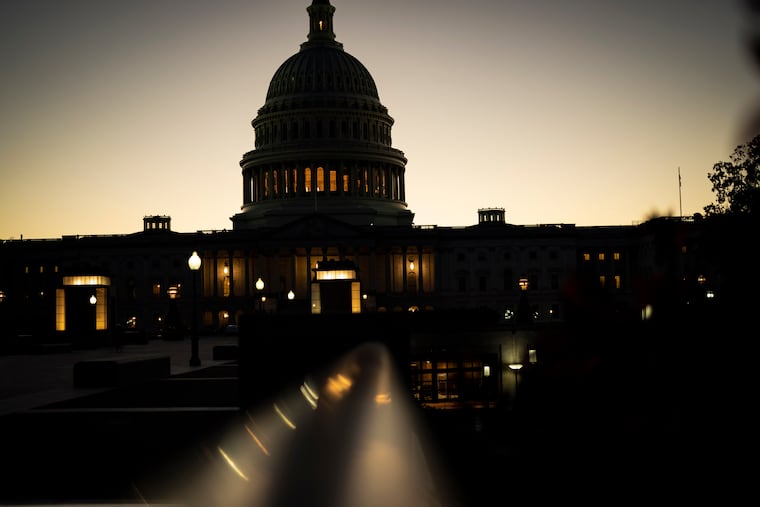Will there be a government shutdown this year? Here’s where things stand.
Congressional leaders announced an agreement Sunday on a short-term spending bill that would fund federal agencies for about three months.

A government shutdown has been averted — for now.
Congressional leaders announced an agreement Sunday on a short-term spending bill that would fund federal agencies for about three months. The agreement would circumvent the potential partial government shutdown when the new budget year begins Oct. 1 and pushes final decisions until after the November presidential election.
Temporary spending bills generally fund agencies at current levels, but an additional $231 million was included to bolster the Secret Service following the two assassination attempts against Republican presidential nominee Donald Trump. Additional money was added to aid with the presidential transition, among other things.
The House had until Sept. 30 to pass a spending bill.
House Speaker Mike Johnson called the agreement a compromise to avoid a shutdown so close to the presidential election.
“While this is not the solution any of us prefer, it is the most prudent path forward under the present circumstances,” Johnson wrote in a letter to his Republican colleagues. “As history has taught and current polling affirms, shutting the government down less than 40 days from a fateful election would be an act of political malpractice.”
Here’s what you need to know about the agreement and government shutdowns.
What is a government shutdown?
Traditionally, 12 annual appropriation bills outline funding for the various U.S. government agencies. Those bills are lumped together into a single “omnibus” package where they are approved in one vote.
Part of the existing spending plans are set to expire Sept. 30, at the end of the government’s fiscal year. Now, the agreement will extend funding through mid-December.
That gives the current Congress the ability to fashion a full-year spending bill after the Nov. 5 election, instead of pushing that responsibility to the next Congress and president.
But the agreement on the short-term measure does not mean getting to a final spending bill will be easy come December. The election results could also influence the political calculations, potentially pushing the fight into early next year.
Who is affected by a government shutdown?
When a shutdown happens, the government isn’t able to spend money — with some exceptions — meaning that federal employees across the country would be expected to work without pay until the shutdown ends or face furloughs. In turn, essential services would continue to operate, but resources would be significantly strained.
Hundreds of thousands of federal employees are impacted by government shutdowns. Those who are expected to work do not receive pay until after the shutdown has ended. The employees are guaranteed back pay. Many employees are also at risk of being furloughed and would not be allowed to work (but would also receive back pay thanks to legislation passed in 2019).
Some of the main groups of employees who could be impacted include active military members, federal law enforcement, federal transportation workers (such as air traffic controllers and TSA agents, but not SEPTA), national park employees, scientific researchers, and some health-care providers.
When would the government shut down?
Under the new extension, Congress and President Joe Biden’s administration will now need to reach an agreement by Dec. 20 at midnight. If they don’t, a shutdown would go into place on Dec. 21 at 12:01 a.m.
What was the longest government shutdown?
The longest, and most recent, government shutdown lasted 34 days, from Dec. 22, 2018, through Jan. 25, 2019. It was the second government shutdown to occur during Trump’s presidency. That shutdown ended after East Coast airports faced major delays when unpaid air traffic controllers stopped coming to work.
Last year, lawmakers narrowly avoided a federal shutdown when the House and Senate agreed on a short-term funding deal that Biden signed into law minutes before deadline.
What could a government shutdown mean for Philly?
In Philadelphia, the most recent government shutdown led to the closing of Independence Hall and the Liberty Bell Center.
Last year, the U.S. Department of Interior said that all National Park Service locations would close if a government shutdown went into effect, impacting Independence Hall, the Liberty Bell, and Valley Forge. The agency had not released guidance for this year as of publication time.
The city’s Immigration Court was closed during the 2018-19 shutdown, accepting only emergency filings for people already in detention.
Most federal eastern Pennsylvania law enforcement officers continued to work without pay, but some employees deemed nonessential were temporarily furloughed. Essential Philadelphia International Airport employees continued to work without pay, but resources were strained, with some air traffic controllers furloughed.
Workers at shelters that serve vulnerable populations and rely on federal funding worried about when payments would come.
What happens next?
The current Congress will aim to hammer out a final bill after the November general election and get it to Biden’s desk for his signature by the end of Dec. 20.
The Associated Press contributed to this article.